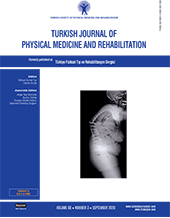Comparison of effectiveness of different kinesiological taping techniques in patients with chronic low back pain: A double-blind, randomized-controlled study
2 Department of Physical Medicine and Rehabilitation, Bülent Ecevit University Faculty of Medicine, Zonguldak, Turkey
3 Department of Biostatistics, Bülent Ecevit University Faculty of Medicine, Zonguldak, Turkey DOI : 10.5606/tftrd.2019.3712 Objectives: This study aims to investigate the effects of kinesiological taping (KT) method combined with physiotherapy modalities and exercise therapy on the severity of pain, range of lumbar motion, and degree of disability.
Patients and methods: Between November 2015 and November 2016, a total of 125 patients (63 males, 62 females; mean age 45 years; range, 20 to 65 years) who were diagnosed with chronic non-specific low back pain were included in this double-blind, randomized, placebocontrolled study. The patients were randomly assigned to four groups. All groups received the same physiotherapy modalities and exercise therapy. Group 1 received physiotherapy modalities and exercise therapy alone; Group 2 received additional sham KT; Group 3 received additional KT with a space correction technique; and Group 4 received additional KT with a fascia correction technique. Kinesiological taping was applied for three weeks with five-day intervals and four times in total. The patients were evaluated at baseline (Day 0), at the end of the treatment (Day 21), and on Day 51. Pain severity using the visual analog scale (VAS), ranges of lumbar motion using the fingertip-tofloor distances and modified lumbar Schober test, and the degree of disability using the Oswestry Disability Index (ODI) and Roland Morris Disability Questionnaire (RMDQ) were evaluated.
Results: We found a significant difference among the groups in terms of VAS motion T0-51 changes (p<0.05). There was also a significant difference among the groups in terms of T0-21 and T0-51 changes in the ODI and RMDQ (p<0.05).
Conclusion: Our study results suggest that KT ensures reduction in pain and disability, irrespective of the technique of taping, with sustainable short-term effects following the end of the treatment.
Keywords : Chronic pain, exercise therapy, kinesiotaping, lumbago, physiotherapy

















